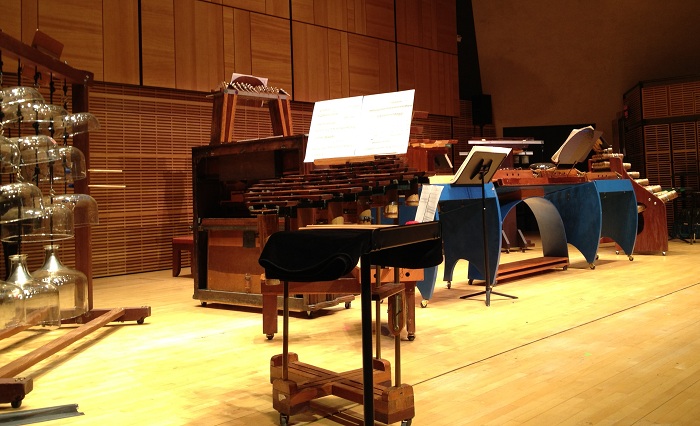
S ome works begin their performance life in a shocking way but, with further performances, come to feel ‘more normal’. Not so with David Del Tredici’s ‘Syzygy’. It was composed in 1966, yet it retains all of its novelty and magic. It continues for me to be a source of wonder … and terror…”A fine program at Zankel Hall last night! Excellent New York premiére of Mason Bates’s 2011 ‘Mass Transmission’ for choir, organ, and electronica. A chamber orchestra comprised of members of San Francisco Symphony members gave a stirring account of Lou Harrison’s 1973 ‘Concerto for Organ and Percussion Orchestra’. And Del Tredici’s 1966 ‘Syzygy’ was just as disturbing as Michael Tilson Thomas promised (esp., the pyrotechnics by soprano Kiera Duffy and Nicole Cash, French horn).
— Michael Tilson Thomas, introductory remarks, Zankel Hall, 29-MAR-2012.
B ut the highlight of the program for me was the 8-person ensemble who performed Harry Partch’s 1958 ‘Daphne of the Dunes’, using Partch’s original one-off, home-made instruments that had been shipped cross-country in two semi tractor-trailers for Carnegie Hall’s ‘American Mavericks’ programs. (Performed by Dean Drummond, harmonic cannon & spoils-of-war; Joe Bergen, harmonic cannon & chromelodeon; Charles Corey, kithara, surrogate-kithara, harmonic cannon; jeffery irving, surrogate-kithara & harmonic cannon; Jared Soldiviero, boo, spoils-of-war, kithara; Bill Ruyle, diamond marimba; Joe Fee, cloud chamber bowls; Greg Hesselink, tenor violin, gourd tree, missile-cone gongs, pre-recorded tape.)
T he spatial arrangements of the instruments’ parts give rise to a spectrum of motions that lie well under the human hand. The physical distances between the strike-positions that produce the notes; the non-monotonic relationship of the parts’ positioning to their pitches; the practical biomechanics of what it is feasible for human arms, and fingers, and feet to do; the sensitivity of the parts, namely, how much force is required to generate a particular sound intensity: all of these contribute to the sonic qualities and musical tendencies of each instrument. The geometries of each instrument are associated with patterns and playing motions and sounds that are natural or characteristic for the instrument and the music to which it contributes. This is true of all instruments, of course; but we tend to under-recognize the fact when we listen to or observe performers of ‘normal’ instruments. With Partch’s compositions, the kinesthetics and biomechanics of the user interface are in our face.
F or example, plucking vertical strings that descend down by your knees, where you have difficulty seeing the strings in the shadows—leaning forward, bending down, and plucking them while standing, perched on a tall, narrow, possibly-catastrophically-tippy bench—while the music is located on a frail, kludgy stand way up above your head—these features impart an inherent, peculiar urgency and anxiety to the playing, which on account of these reasons is very different from the sound of a harp played by a performer who is comfortably and safely seated. The emotional quality of the sound is dramatically different, despite the fact that the mechanism of sound production is substantially the same in the two instruments.
W hat an evening!—showcasing compositions that have their own internal reasons for being, mostly refusing to cater to any external audience! And, with the exception of the Mason Bates piece (commissioned by San Francisco Symphony, with support of Michele and Laurence Corash), innovating things with slim expectation of popularity or compensation within the composer’s lifetime. Price of vision.
- American Mavericks Series
- Mason Bates website
- Lou Harrision Documentary Project website
- David Del Tredici website
- HarryPartch.com
- Adelaide C. An Exploration of Outsider Art. Webster, 2011.
- Dunn D, ed. Harry Partch: An Anthology of Critical Perspectives. Routledge, 2000.
- Gilmore B. Harry Partch: A Biography. Yale Univ, 1998.
- Hopkin B. Musical Instrument Design: Practical Information for Instrument Design. SeeSharp, 1996.
- Maclagan D. Outsider Art: From the Margins to the Marketplace. Reaktion, 2010.
- Partch H, Blackburn P, eds. Harry Partch: Enclosure 3. ACF, 1997.
- Partch H. Bitter Music: Collected Journals, Essays, Introductions, and Librettos. (Thos. McGeary, ed.) Univ Illinois, 2000.
- Partch H. Genesis of a Music: An Account of a Creative Work, Its Roots, and Its Fulfillments. 2e. Da Capo, 1979.
- Tommasini A. On a mission to celebrate the different. NY Times, 24-FEB-2012.
- Walker Art Center. Naives & Visionaries. Dutton, 1974.
No comments:
Post a Comment